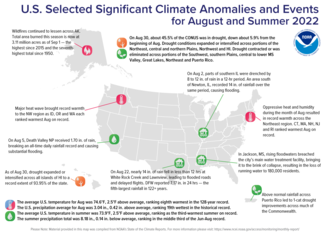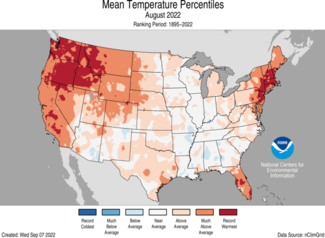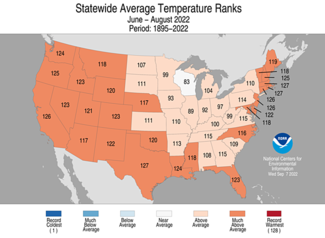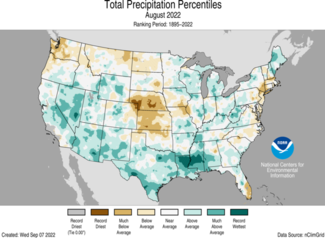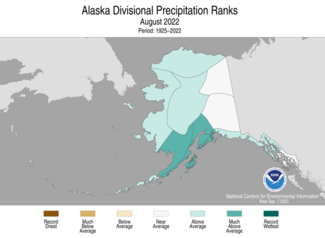Third-Warmest Summer on Record for the Lower 48
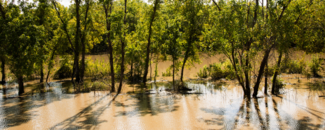
Key Points:
- The average temperature of the contiguous U.S. in August was 74.6°F, which is 2.5°F above average, ranking eighth warmest in the 128-year record. Generally temperatures were above average and/or record-warm across much of the U.S.
- The contiguous U.S. monthly average minimum temperature was record warm for the second month in a row during August. California, Oregon, Washington, Nevada and Idaho each ranked warmest on record for August nighttime temperatures.
- The meteorological summer (June-August) average temperature for the Lower 48 was 73.9°F, 2.5°F above average, ranking as the third-warmest summer on record.
- August precipitation for the contiguous U.S. was 3.04 inches, 0.42 inch above average, ranking in the wettest third of the historical record. Precipitation was above average across parts of the Midwest, West, southern Mississippi Valley and Plains. Precipitation was below average across portions of the central and northern Plains, Northwest and parts of the northern Atlantic coastline.
- The National Weather Service deemed heavy rainfall episodes in southern Illinois, Death Valley National Park, and Dallas, TX as 1,000-year events. While extensive flooding occurred with the heavy rain, some of these events helped to reduce the severity of the drought across portions of the West and southern Plains.
- For the first time since 1997, there was no storm activity reported in the North Atlantic basin during the month of August.
- The wildfire season appears to be waning across Alaska but is still going strong across the West and southern Plains. Across all 50 states, more than 6 million acres burned from January 1 through August 31, 2022.
- According to the August 30 U.S. Drought Monitor report, 45.5 percent of the contiguous U.S. was in drought. Severe to exceptional drought was widespread from the Great Basin to the Pacific Coast, across portions of the central and southern Plains, and parts of New England.
Other Highlights:
Temperature
For the month of August, Washington, Oregon, Idaho, New Jersey, Connecticut, Rhode Island, Massachusetts and New Hampshire ranked warmest on record. In addition to this record warmth, near-record temperatures were widespread in the West and other parts of the Northeast. California had its second warmest August, with five additional states experiencing a top-five warmest August on record.
Summer temperatures were above average across most of the contiguous United States. Texas, Massachusetts and Rhode Island ranked second warmest while seventeen additional states across the West, South and Northeast ranked among their warmest 10 summer seasons on record.
For the January-August period, the average contiguous U.S. temperature was 55.4°F, 1.5°F above average, ranking in the warmest third of the record. Temperatures were above average from Oregon to the Gulf Coast and from the Gulf to New England. Florida ranked fourth warmest and California ranked fifth warmest on record for this period. Temperatures were below average across parts of the Upper Midwest.
The Alaska statewide August temperature was 50.1°F, 0.6°F above the long-term average. This ranked among the middle one-third of the 98-year period of record for the state. Temperatures were above average across much of eastern Alaska, Panhandle region, Kodiak Island and portions of the Kenai Peninsula. Temperatures were below average across portions of northwest Alaska.
The Alaska summer temperature was 52.1°F, 1.6°F above the long-term average, ranking in the warmest third of the record for the state. Temperatures were above average across most of the state with the Northwest and areas along the Arctic near average for the season.
The Alaska January-August temperature was 31.2°F, 2.5°F above the long-term average, ranking in the warmest third of the record for the state. Above-average temperatures were observed across much of the state with portions of the North Slope, West Coast and eastern interior regions experiencing near-average conditions for this eight-month period.
Precipitation
Record rainfall events during the month of August contributed substantially to the record-wet August for Mississippi as well as the third-wettest August for Nevada and Louisiana. Conversely, a lack of precipitation received during the month resulted in Nebraska ranking second driest while Kansas had its seventh-driest August on record.
The U.S. summer precipitation total was 8.18 inches, 0.14 inch below average, ranking in the middle third of the June-August record. Precipitation was above average along the West Coast, much of the Southwest, Midwest, lower Mississippi Valley and northern New England for the season. Precipitation during June-August was below average across the Great Plains, southern New England, and other portions of the East Coast. Arizona ranked seventh wettest while Nebraska ranked third driest for the summer season.
The January-August precipitation total for the contiguous U.S. was 19.68 inches, 1.03 inches below average, ranking in the driest third of the historical record. Precipitation was above average across parts of the northern Plains, Midwest, and much of the southern Mississippi, Tennessee and Ohio valleys. Precipitation was below average across much of the West, central and southern Plains and parts of the Northeast during the January-August period. California ranked driest on record while Nebraska ranked fifth driest and Nevada ranked seventh driest for this eight-month period.
Alaska had the 10th-wettest August in the 98-year record. Much of the state was wetter-than-average, with portions of eastern Alaska and lower Panhandle experiencing near-average conditions during the month. Homer recorded its wettest August and Anchorage ranked third-wettest on record.
For the summer season, precipitation ranked in the wettest third of the record for Alaska with wetter-than-average conditions observed in the North Slope, West Coast and southern portions of the state, with parts of the Northeast interior drier than average for the season.
The January-August precipitation ranked 10th-wettest on record for Alaska, with above average precipitation observed across all but the central and northeast Interior and Aleutian regions.
Other Notable Events
Several notable flooding events, considered “1,000-year” rainfall events by the National Weather Service, occurred during the month of August:
- On August 2, parts of southern Illinois were drenched by 8 to 12 inches of rain in a 12-hour period. An area south of Newton, Illinois, recorded 14 inches of rainfall over the same period.
- On August 5, Death Valley National Park received 1.70 inches of rain, an unprecedented amount of rainfall for the area, resulting in substantial flooding and damage, and trapping visitors and staff members. This event broke the previous all-time 24-hour rainfall record of 1.47 inches recorded on April 15, 1988.
- On August 22, parts of Dallas, Texas saw more than 13 inches of rainfall within 12 hours. The governor declared a disaster for 23 Texas counties, including Dallas, after storms caused damage and devastating flash flooding.
On September 1, the Great Salt Lake, the largest saltwater lake in the Americas and eighth largest in the world, recorded its lowest water level since records began in 1847.
August had no storm activity in the North Atlantic basin, with 2022 becoming only the third year, along with 1961 and 1997, since 1950 to have no activity during the month.
Drought
According to the August 30 U.S. Drought Monitor report, about 45.5 percent of the contiguous United States was in drought, down about 5.9 percent from the beginning of August. Drought conditions expanded or intensified across portions of the Northeast, central and northern Plains, Northwest and Hawaii. Drought contracted or was eliminated across portions of the Southwest, southern Plains, central to lower Mississippi Valley, Great Lakes, parts of the Northeast and Puerto Rico. Drought covered 93.95% of the state of Hawaii – the largest extent ever recorded for that state.
Monthly Outlook
According to the August 31 One-Month Outlook from the Climate Prediction Center, much of the West to the Midwest and from the Midwest to the East Coast, as well as southeast Alaska, have the greatest chance of receiving above-normal temperatures in September, whereas the greatest chance for below-normal temperatures is projected to occur across portions of the southern Plains. Portions of the Southwest, Gulf Coast, Southeast and the Panhandle of Alaska are projected to have the greatest chance of above-normal precipitation, while the greatest chance for below-normal precipitation is expected to occur from Northwest to the Great Lakes and into New England. Drought is likely to persist across much of the West, central Plains, and Hawaii with some improvement and/or drought removal likely from the Southwest to the southern Plains, as well as across portions of Puerto Rico. Drought development is likely across small areas of the central and northern Plains, portions of the Mid-Atlantic and Hawaii.
According to the One-Month Outlook issued on September 1 from the National Interagency Fire Center, Hawaii and portions of the Northwest, Oklahoma and the Northeast have above normal significant wildland fire potential during September.
This monthly summary from NOAA’s National Centers for Environmental Information is part of the suite of climate services NOAA provides to government, business, academia and the public to support informed decision-making. For more detailed climate information, check out our comprehensive August 2022 U.S. Climate Report scheduled for release on September 14, 2022.

